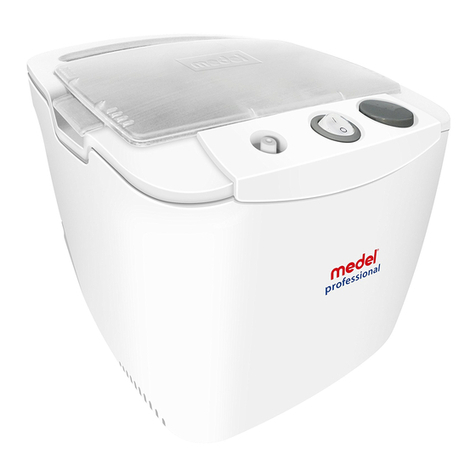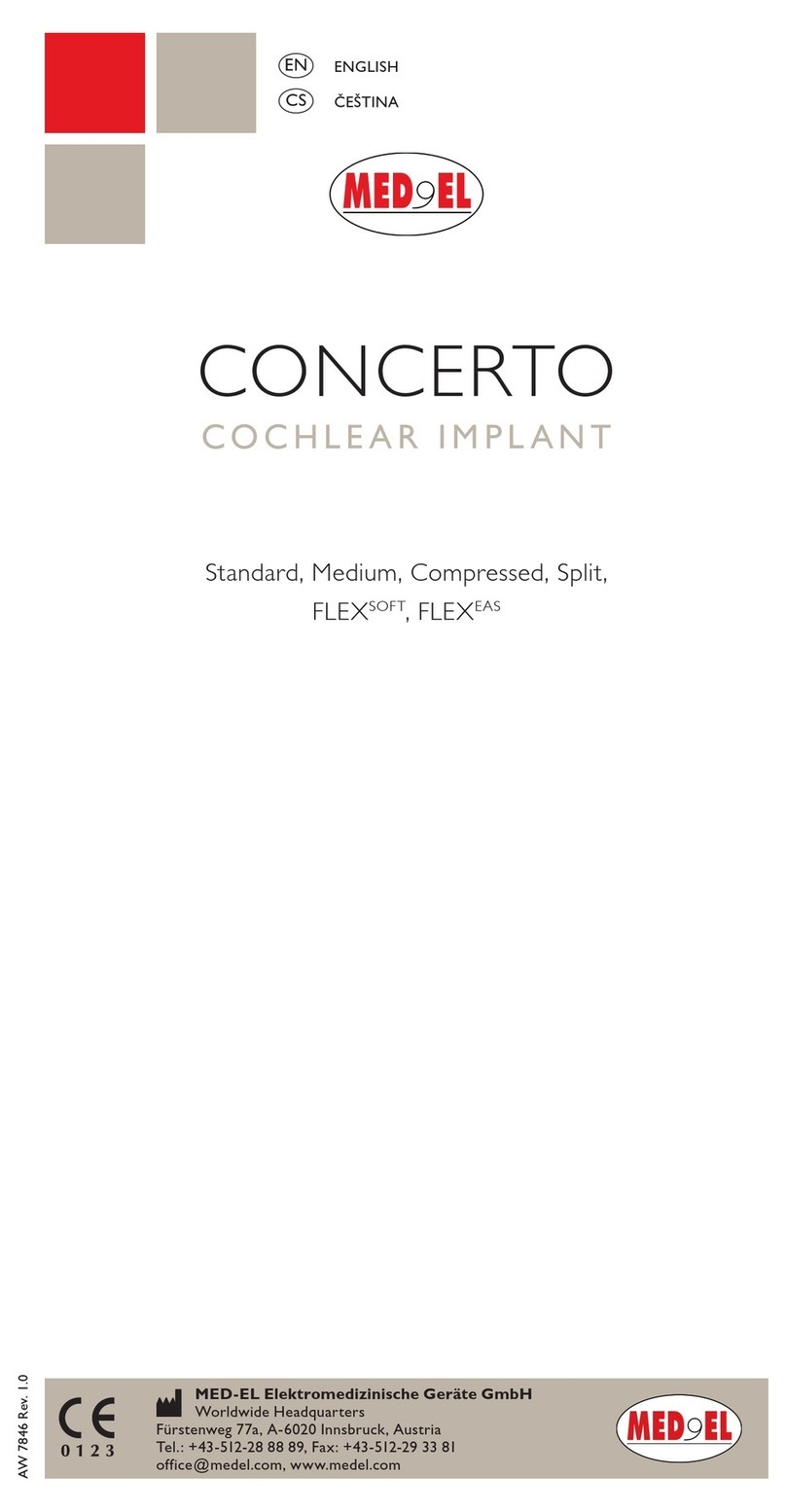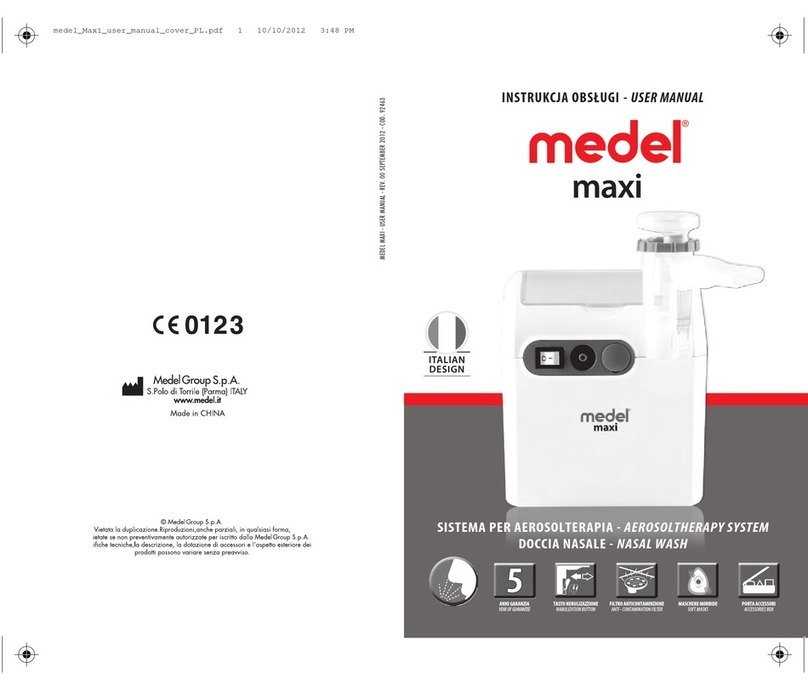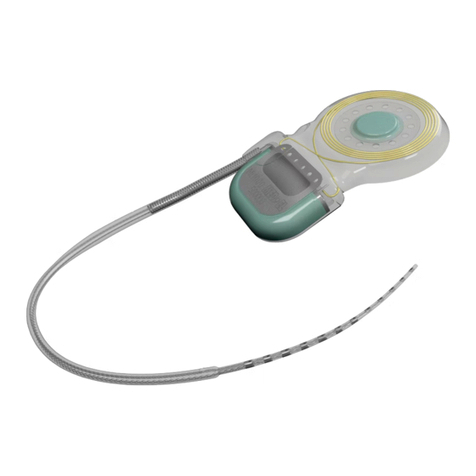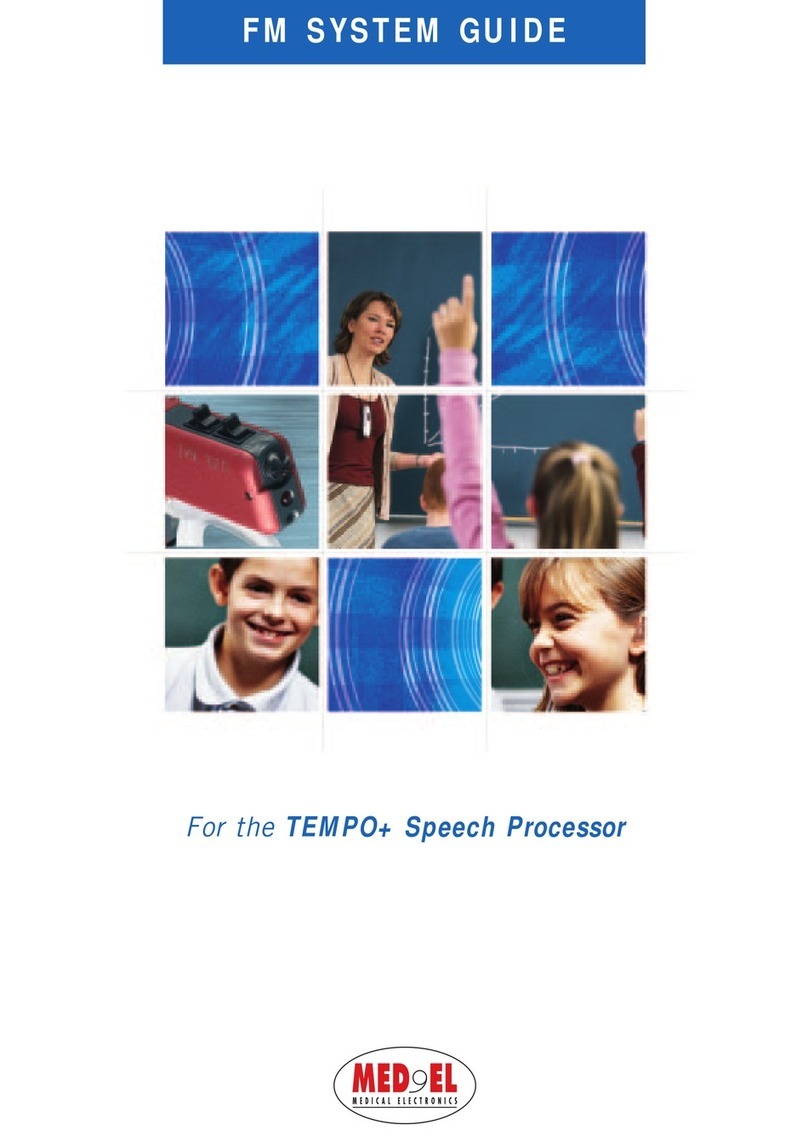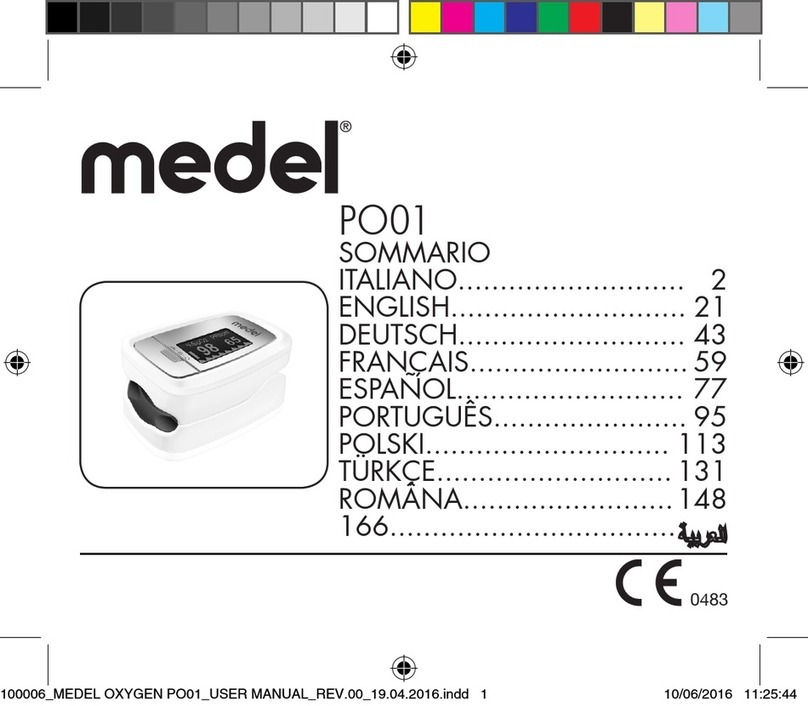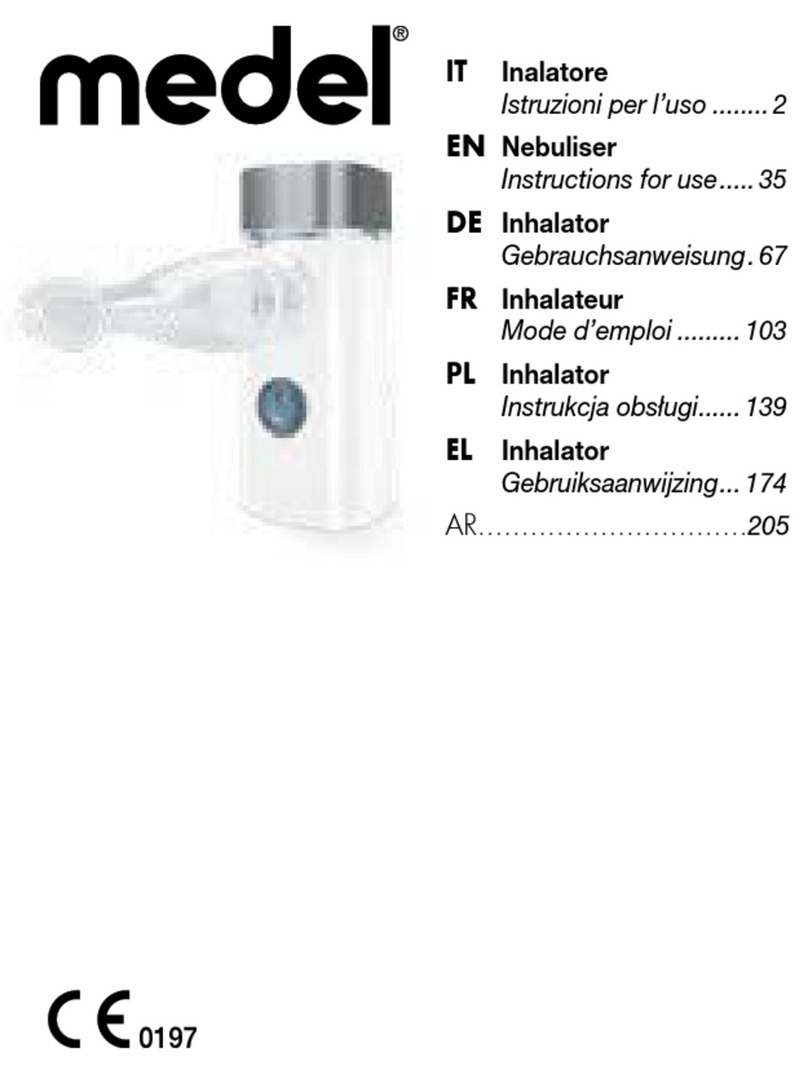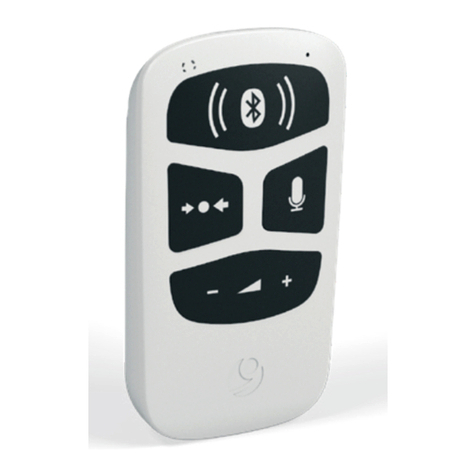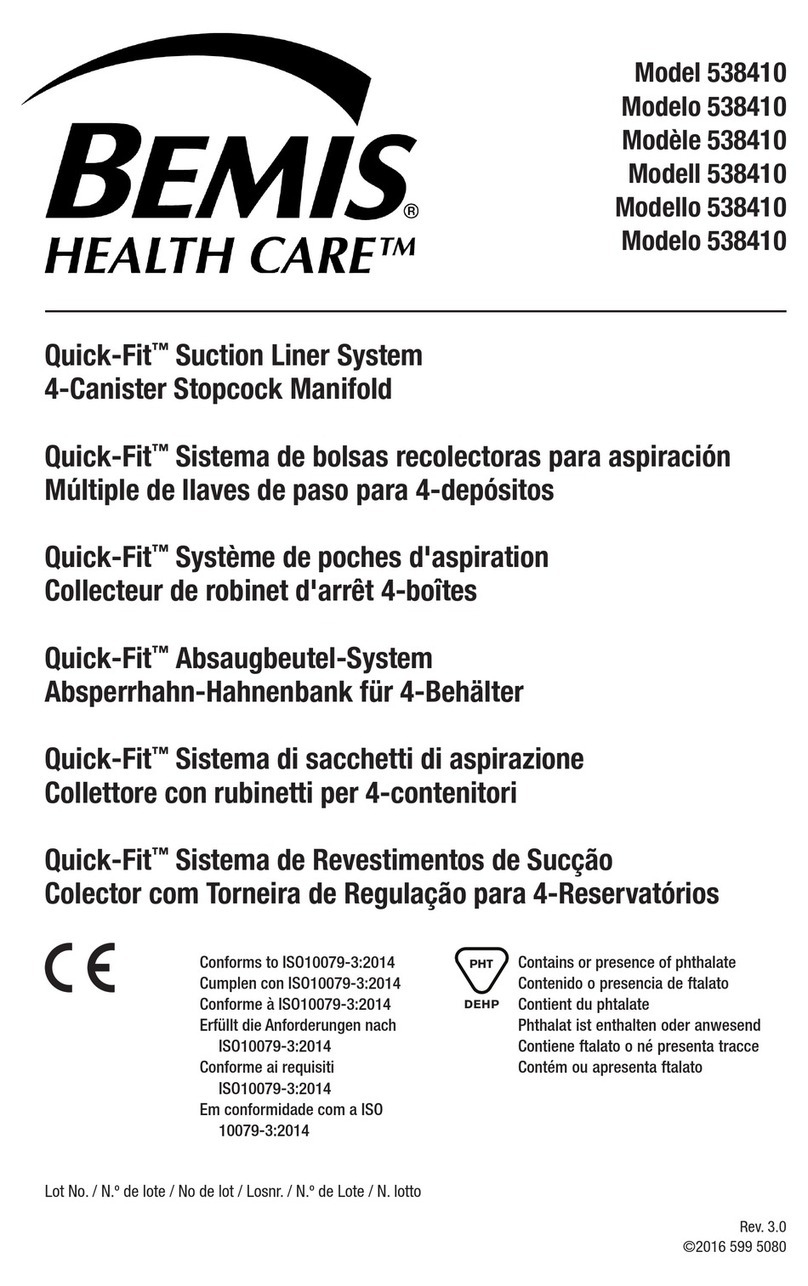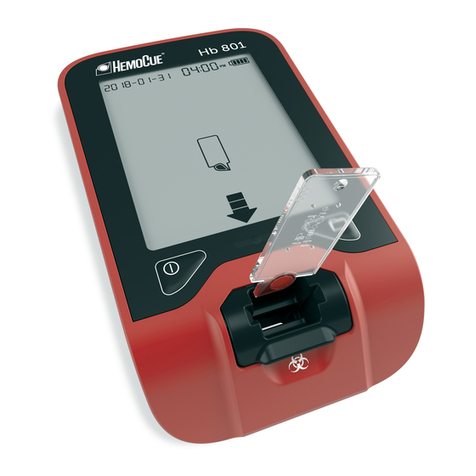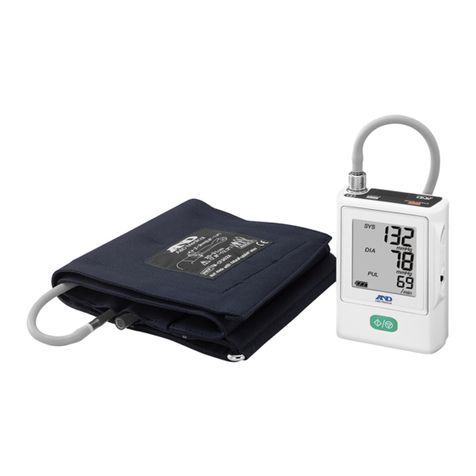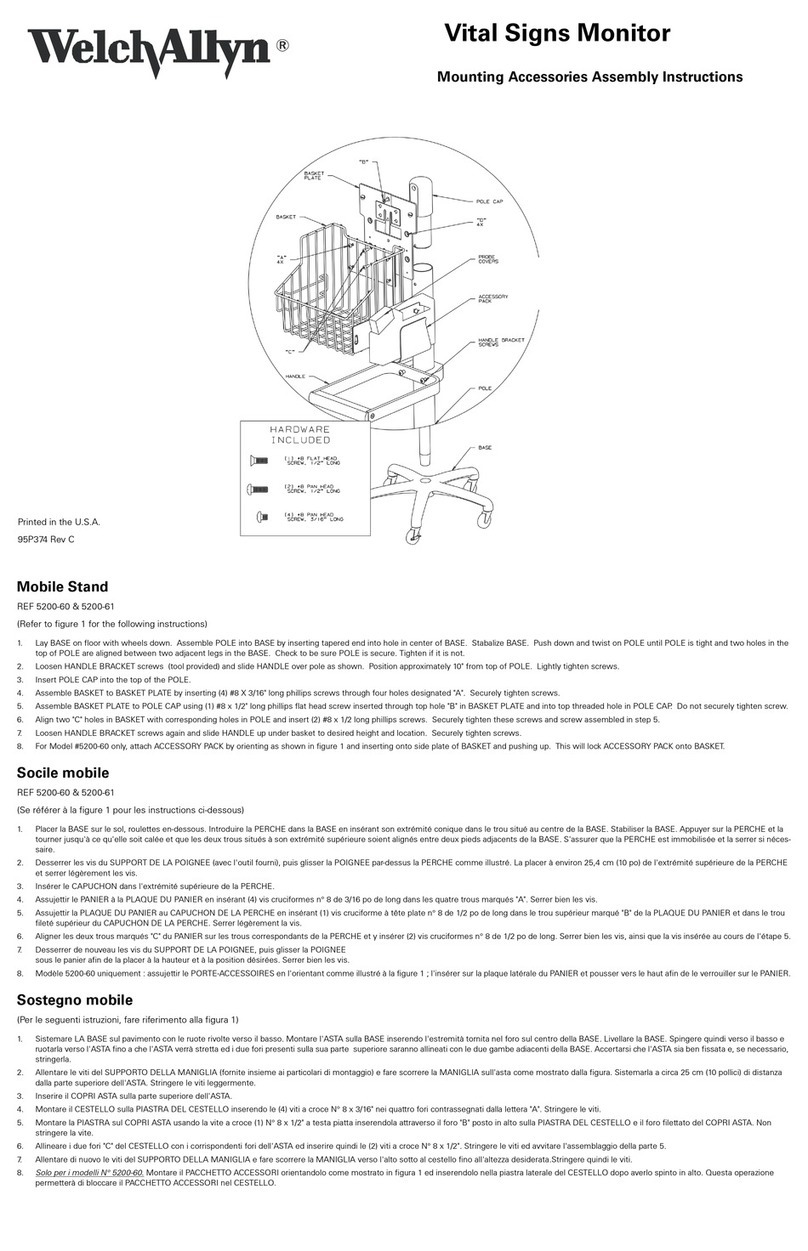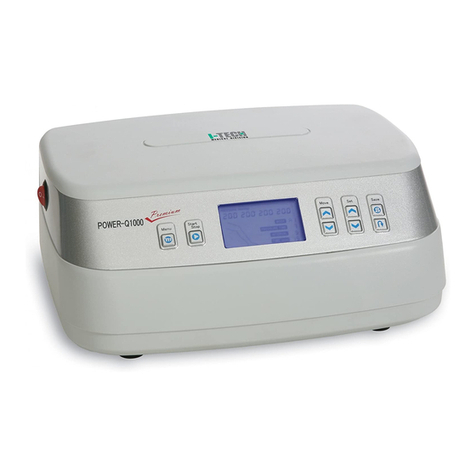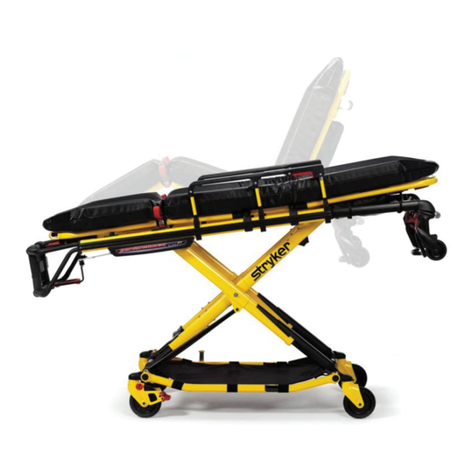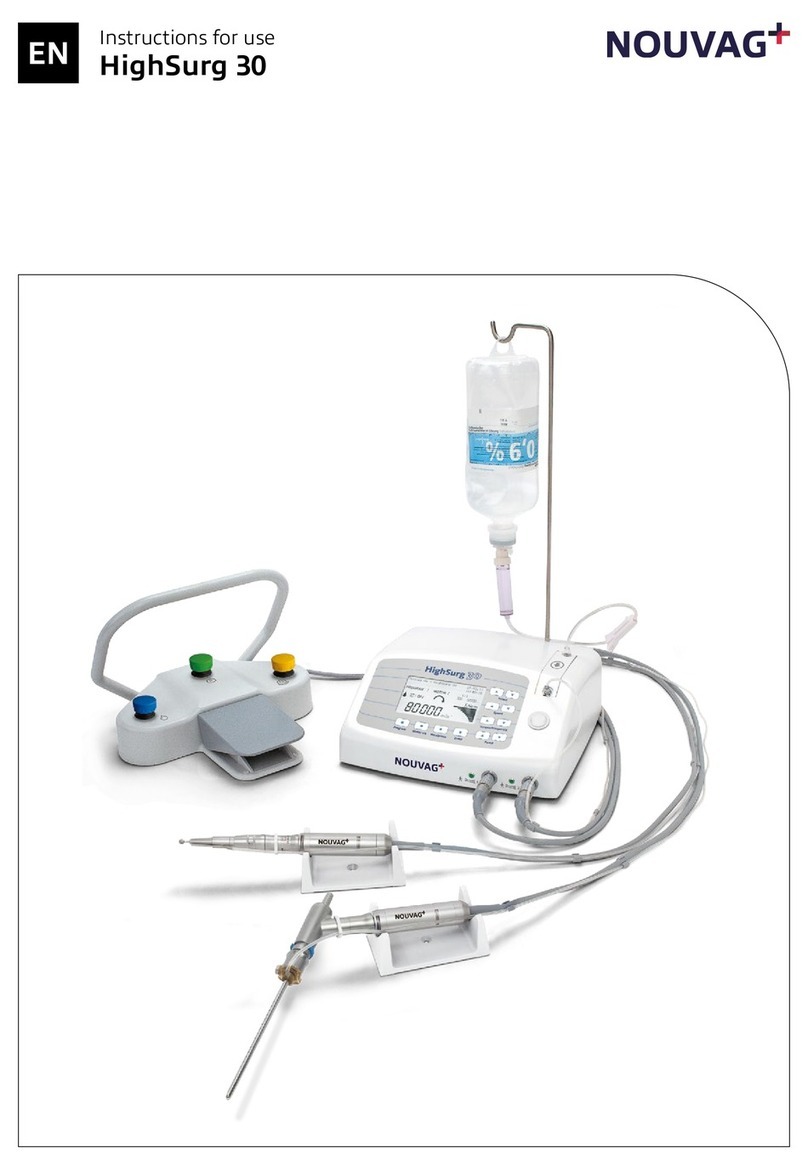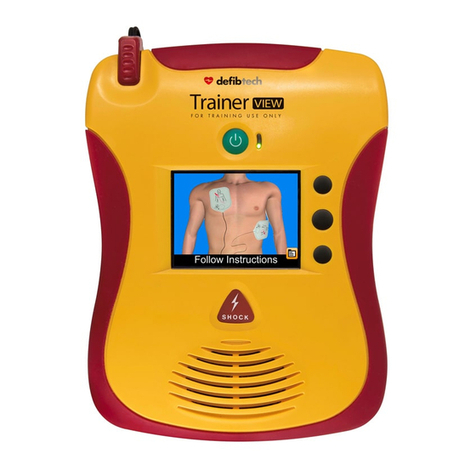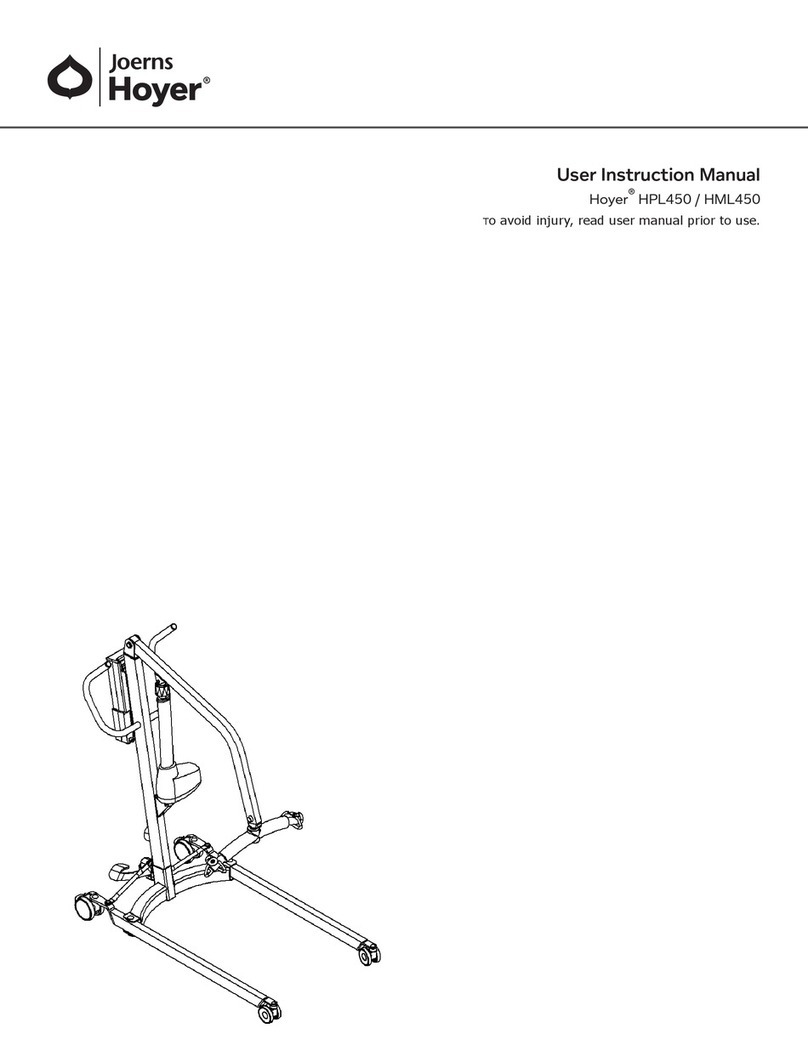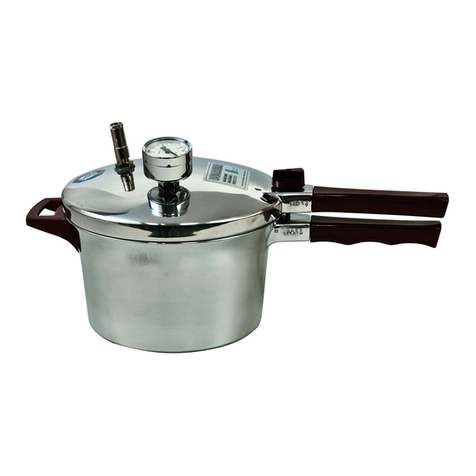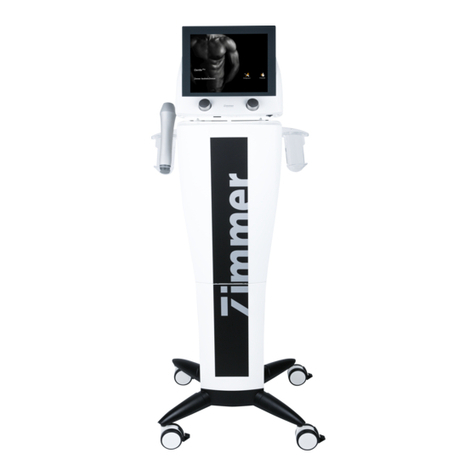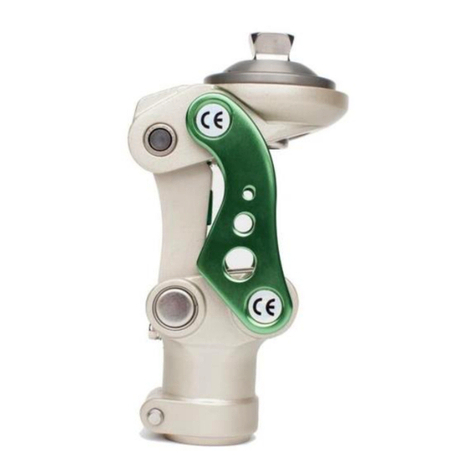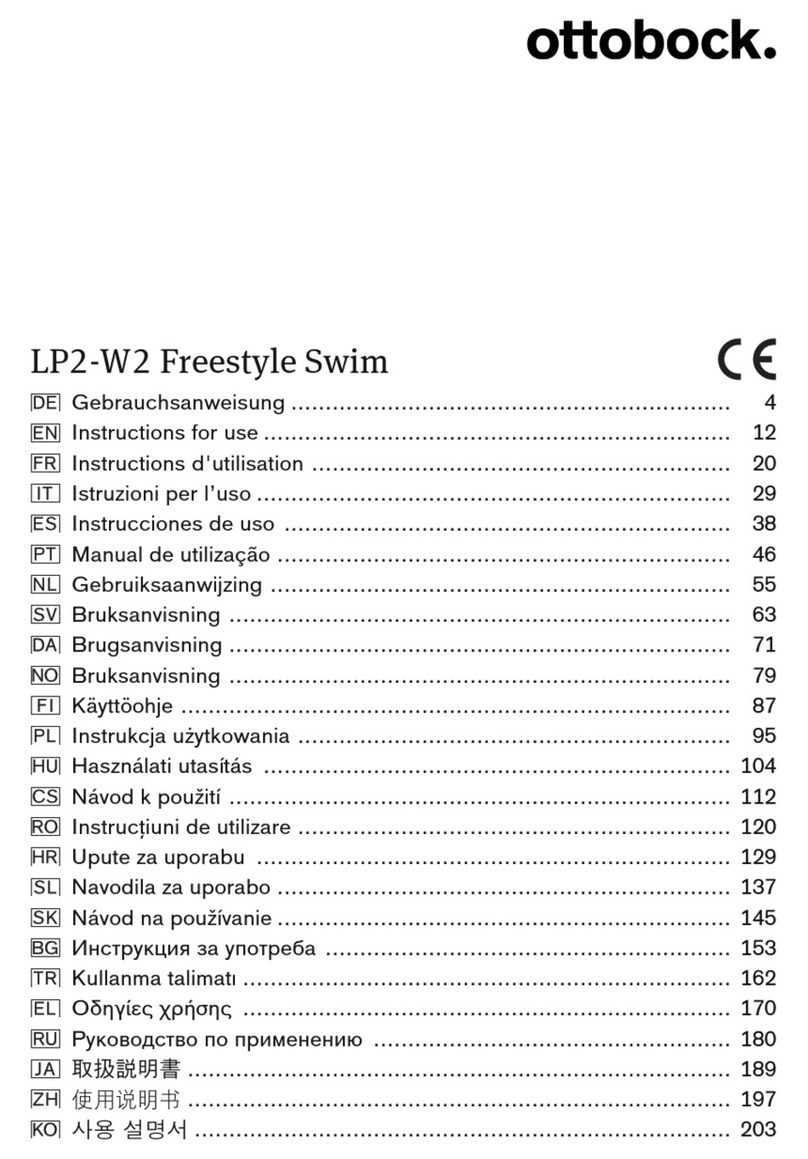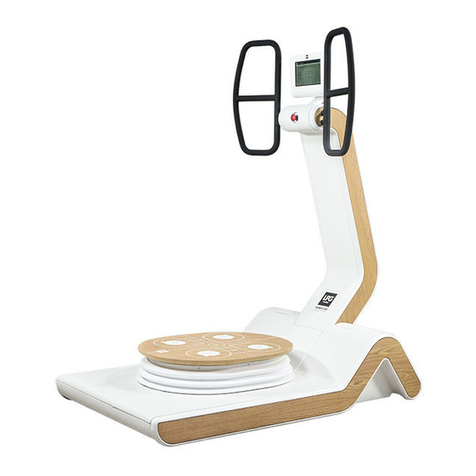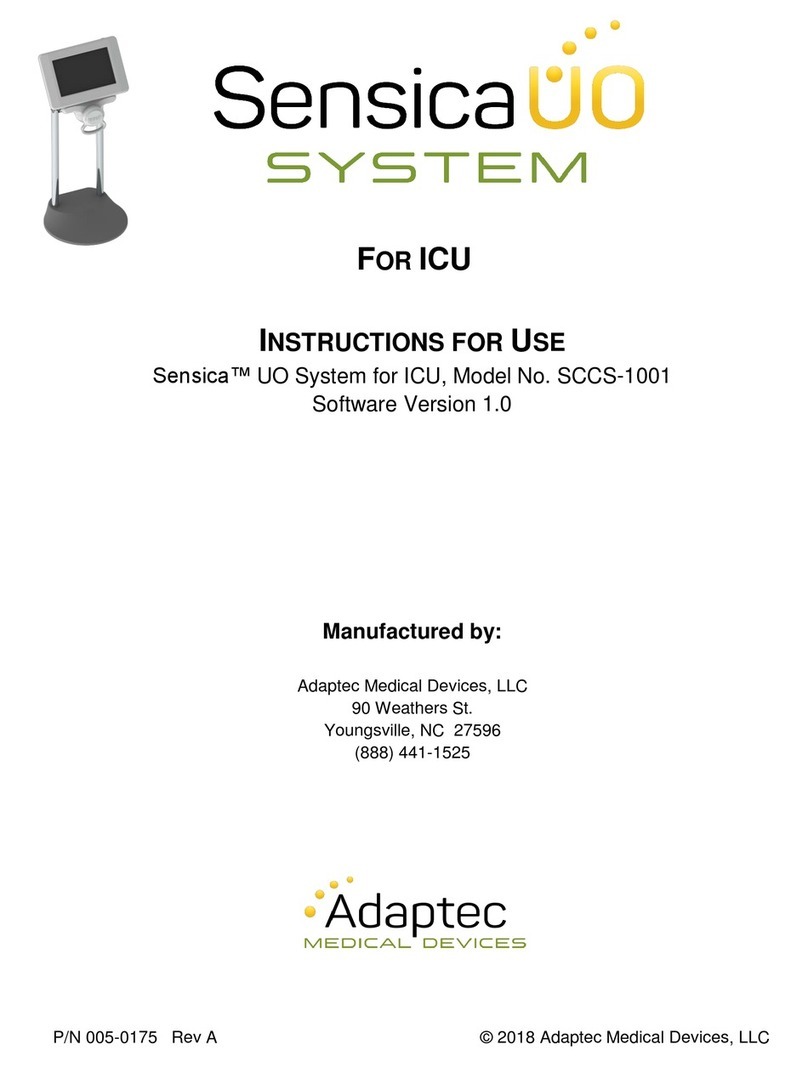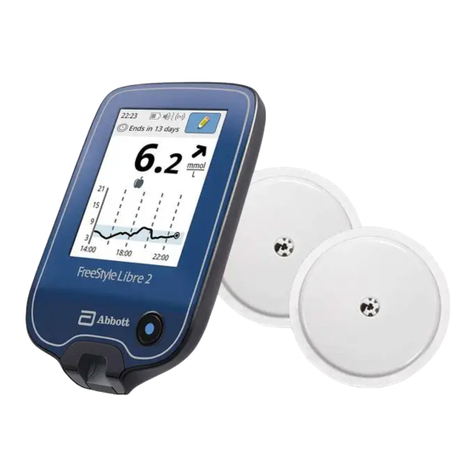Medel Mi1000 CONCERTO PIN Series Instruction Manual

Cochlear Implants
CONCERTO PIN Surgical Guideline
Mi1000
MED‑EL Elektromedizinische Geräte GmbH
Worldwide Headquarters
Fürstenweg 77a
6020 Innsbruck, Austria
medel.com
AW7694_6.0 (English EU)

The MED‑EL Cochlear Implant System serves to restore hearing sensations through electrical stimulation of the auditory
nerve. It is the result of many years of research at leading technical institutions throughout the world.
MED‑EL cochlear implants are manufactured to the highest quality standards in order to ensure long term reliability.
All materials used in the implant have been rigorously tested for biocompatibility, durability and reliability. MED‑EL
applies a quality management system that meets all EN ISO 13485:2003 requirements and complies with US Quality
System Regulations and Canadian Medical Device regulations (CAN/CSA ISO 13485‑2003). Components of the MED‑EL
Cochlear Implant System meet the requirements for AIMD 90/385/EEC and MDD 93/42/EEC.
This Surgical Guideline describes proper techniques for implanting the Mi1000 CONCERTO PIN Cochlear Implant
(hereafter referred to as the CONCERTO PIN). It serves as additional information for professionals and should not be
used as an “Instructions for Use”.
The information in this brochure is believed to be true and correct. However, specications are subject to change without
notice.
Not all products represented on these materials are currently approved or available in all markets. For country specic
information please see the applicable “Instruction for Use” delivered with the implant system.
Introduction

3
Table of contents
I. Patient selection and evaluation 2
Indication 2
Selection and Evaluation 2
II. Technical description of the implant 3
Performance Characteristics 4
Implant Variants 4
III. Surgical tools 9
Surgical Kit for the CONCERTO PIN Cochlear Implant 9
Insertion Test Tools 14
IV. General remarks about the surgery 15
V. Surgical procedure 16
STEP 1: Prepare Patient 16
STEP 2: Mark Implant Position 17
STEP 3: Plan Incision 18
STEP 4-A: Open Skin Flap 19
STEP 4-B: Skin Flap Thickness 20
STEP 5: Check Position of Implant and Electrode Lead 21
STEP 6: Drill Mastoidectomy and Posterior Tympanotomy 22
STEP 7: Drill Stimulator Bed and Electrode Channel 24
STEP 8 – VARIANT 1: Preparation for a Round Window opening 27
STEP 8 – VARIANT 2: Preparation for a Cochleostomy 29
STEP 9: Select Appropriate Electrode Variant 31
STEP 10: Immobilise the Implant 33
STEP 11: Opening the Cochlea 34
STEP 12: Insert the Electrode Array 35
STEP 13-A: Seal Cochlear Opening 38
STEP 13-B: Secure Electrode Lead 39
STEP 14: Intra-operative Recordings 41
STEP 15: Close Wound 42
Appendix 43
MRI Caution 43
X-rays 45
Explanting the Device 45
Hearing Preservation Surgical Technique 46
Literature 48
MED-EL Surgical Videos 52
MED-EL Contacts 52

4
Patient selection and evaluation
I. Patient selection and evaluation
Indication
The MED-EL Cochlear Implant System is intended to evoke
auditory sensations via electrical stimulation of the auditory
pathways. It is designed for severely to profoundly hearing
impaired individuals who obtain little or no benet from
acoustic amplication in the best aided condition.
Additionally the MED-EL Cochlear Implant System used in
combination with the implant variant +FLEX24 or +FLEX20
is intended to evoke auditory sensations via electrical
stimulation or via combined electric-acoustic stimulation
(EAS) of the auditory pathways for partially deaf individuals,
who obtain benet from acoustic amplication in the lower
frequencies only.
The MED-EL Cochlear Implant System is also intended to
evoke auditory sensations via electrical stimulation of the
auditory pathways for individuals with single–sided
deafness, which is dened as severe to profound hearing
impairment in one ear and normal hearing or mild to
moderate hearing impairment in the other ear.
Selection and Evaluation
Patients should full the audiological criteria of their
respective country for open-set sentence testing and
open-set monosyllabic words when tested with hearing
aids. MED-EL strongly recommends the use of optimally
tted hearing aids for a minimum of three months before
deciding to pursue a cochlear implant. In cases of
ossication or deafness due to infectious disease, there
may be no need to try a hearing aid, and implantation
should generally not be delayed.
A complete cochlear implant evaluation protocol should
include an audiologic assessment, a medical/surgical
evaluation, counselling sessions and, when possible, a
psychological assessment. To obtain the optimal benet
from the implant, candidates should be sufciently
motivated and understand the importance of returning to
the implant centre for regular audio processor programming,
training, and assessment sessions.
The medical evaluation prior to cochlear implant surgery
serves to:
• assess the candidate’s health status and ability to
undergo surgery
• verify the absence of disease and infection of the outer
and middle ear
• screen for cochlear obliteration and other obstacles to
electrode insertion
• rule out central auditory lesions and verify a functional
auditory nerve
The above evaluations usually involve an otologic/otoscopic
examination and a CT scan and/or MRI. If there are concerns
about the integrity of the upper auditory pathways and
auditory lesions, an MRI is necessary.
It is important to realise that there are a variety of
conditions that predispose a person to contracting bacterial
meningitis irrespective of cochlear implantation, such as:
malformations of the inner ear, history of recurrent
meningitis, the presence of CSF leaks, etc. There is no
evidence that implantation of a MED-EL device increases
the risk for postoperative meningitis. MED-EL encourages
all cochlear implant candidates and recipients, especially
individuals with cochlear malformations and other risk
factors, to discuss with their physician whether vaccination
may be appropriate for them. The immunisation status of
all cochlear implant candidates should be determined prior
to surgery. Vaccination may reduce the risk of infection.

5
Technical description of the implant
The CONCERTO PIN is the implantable part of the MED-EL
Cochlear Implant System and can only be used together
with compatible MED-EL external components.
The device consists of a stimulator, a coil with a magnet
within its centre, a reference electrode, an EAP reference
electrode and an active electrode permanently attached
to the stimulator. The active electrode can be of different
types, thus resulting in different implant variants (implant
family CONCERTO PIN). This device is intended to be
implanted by adequately trained and experienced surgeons
only.
The CONCERTO PIN has been designed according to the
highest safety and reliability standards. All materials used
in the construction of the CONCERTO PIN have been
extensively tested for biological compatibility and durability.
The power required by the implant is transmitted from the
external audio processor through the intact skin via an
inductive link. The implant therefore contains no batteries
or other components that require replacement.
The implant offers a stimulation mode and a telemetry
mode. Stimulation sequences of biphasic and triphasic
pulses can be delivered sequentially or simultaneously on
two or more channels. In telemetry mode the device allows
a functional check about the technical status of the implant
including communication over the transcutaneous link as
well as the assessment of the electrode impedances and
recording of the electrically evoked compound action
potential of the hearing nerve.
The electronics of the CONCERTO PIN contain a powerful
custom-made circuit that is capable of processing large
amounts of information at a very rapid rate. It can stimulate
at 50,704 pulses per second. This capability makes the
implant compatible with a wide range of pulsatile processing
strategies and future developments in speech processing.
A telemetry feature enables the clinic to verify the
functional status of the implant within a matter of seconds.
For added safety, each output has a capacitor to prevent
any possible leakage of DC current to the auditory nerve.
II. Technical description of the implant
Figure 1 CONCERTO PIN Cochlear Implant (~ dimensions
in mm, typical values)

6
Technical description of the implant
Performance Characteristics
• Output characteristics of a stimulation signal on a 1
kOhm resistor:
Maximum current amplitude:
Median value = 1250µA, range = 500µA
Maximum pulse width:
Median value = 203.8 µs, range = 8.2 µs
• The impedance measurement accuracy is typically
better than 5%.
• When keeping to the safety guidelines the implant is
conditionally MRI safe for MR scanner field strengths
of 0.2 Tesla, 1.0 Tesla and 1.5 Tesla.
• There are no default factory settings of the implant
system.
• Proper functioning of the implantable part of the CI
system can be checked by performing telemetry (refer
to MED-EL application software user manual).
• The implant has 24 independent current sources
stimulating 12 independent electrode channels in
monopolar mode.
• The implant has a mass of 7.6g (typical value).
• The volume of the implant without electrode is 3.7 cm³.
• The electrode is made of medical grade silicone,
platinum (electrode contacts) and platinum/iridium
(90/10) wires and nitinol.
• All electrode variants have a straight and flexible design.
The electrode does not deliver any medicinal
substances.
• Geometric surface area of the stimulation reference
electrode = 50 mm².
• Following materials are in direct contact with human
tissue: medical grade silicone, platinum, iridium and
titanium.
Implant Variants
Cochleae may differ signicantly in size and shape from
one another as can individual cochlear duct lengths.
MED-EL offers the largest selection of electrode arrays for
each implant variant. Please see Section V, Step 9, “Select
Appropriate electrode Variant” for the circumstances in
which each variant should be used.
FLEXSOFT Electrode Array
Order number: 07680
The FLEXSOFT Electrode Array (see Figure 2) is 31.5 mm
long featuring FLEX tip technology for increased mechanical
exibility and enabling CCC (Complete Cochlear Coverage).
The contacts for the 12 channels are arranged as 5 single
contacts at the apical array end and 7 contact pairs at the
base with a 2.4mm spacing between each channel. The
specially designed electrode tip offers increased mechanical
exibility for reduced insertion force. The marker ring is
located 31.5mm from the electrode tip and indicates the
deepest insertion. Near the marker ring, the electrode lead
features an additional marker dot on the same side of the
array as the single apical contacts. The marker allows the
surgeon to ensure appropriate alignment of the single
contacts toward the modiolus.
Ø 1.3mm
Active Stimulation Range: 26.4mm
FLEX-Tip
31.5mm
23
1
0.5 x 0.4mm
119 platinum electrode contacts
Optimal spacing over a 26.4 mm stimulation range
2Diameter at basal end: 1.3m
3FLEX-Tip for minimal insertion trauma
Dimensions at apical end: 0.5 x 0.4mm
Figure 2 FLEXSOFT Electrode Array
* Implant variants availability is subject to regulatory approval
*

7
Technical description of the implant
FLEX28 Electrode Array
Order number: 08841
The FLEX28 Electrode Array (see Figure 3) is 28 mm long
featuring FLEX tip technology suitable for 96% of all normal
cochlear duct lengths. The contacts for the 12 channels
are arranged as 5 single contacts at the apical array end
and 7 contact pairs at the base with a 2.1mm spacing
between each channel. The specially designed electrode
tip offers increased mechanical exibility for reduced
insertion force. The marker ring is located 28mm from the
electrode tip and indicates the deepest insertion. Near the
marker ring, the electrode lead features an additional
marker dot on the same side of the array as the single
apical contacts. The marker allows the surgeon to ensure
appropriate alignment of the single contacts toward the
modiolus.
0.5 x 0.4mm
Ø 0.8mm
Active Stimulation Range: 23.1mm
FLEX-Tip
28mm
23
1
119 platinum electrode contacts
Optimal spacing over a 23.1 mm stimulation range
2Diameter at basal end: 0.8mm
3FLEX-Tip for minimal insertion trauma
Dimensions at apical end: 0.5 x 0.4mm
Figure 3 FLEX28 Electrode Array
FLEX24 Electrode Array
Order number: 07679
The FLEX24 Electrode Array (see Figure 4) is 24 mm long
featuring FLEX tip technology and designed for combined
Electric Acoustic Stimulation (EAS) less than 1.5 turns. The
contacts for the 12 channels are arranged as 5 single
contacts at the apical array end and 7 contact pairs at the
base with a 1.9mm spacing between each channel. The
specially designed electrode tip offers increased mechanical
exibility for reduced insertion force. The marker ring is
located 24mm from the electrode tip and indicates the
deepest insertion. Near the marker ring, the electrode lead
features an additional marker dot on the same side of the
array as the single apical contacts. The marker allows the
surgeon to ensure appropriate alignment of the single
contacts toward the modiolus.
0.5 x 0.3mm
Ø 0.8mm
Active Stimulation Range: 20.9mm
FLEX-Tip
24mm
23
1
119 platinum electrode contacts
Optimal spacing over a 20.9 mm stimulation range
2Diameter at basal end: 0.8mm
3FLEX-Tip for minimal insertion trauma
Dimensions at apical end: 0.5 x 0.3mm
Figure 4 FLEX24 Electrode Array
EAS SURGICAL TRAINING RECOMMENDED
EAS

8
Technical description of the implant
FLEX20 Electrode Array
Order number: 30969
The FLEX20 Electrode Array (see Figure 5) is 20 mm long
featuring FLEX tip technology and designed for combined
Electric Acoustic Stimulation (EAS). The contacts for the 12
channels are arranged as 5 single contacts at the apical
array end and 7 contact pairs at the base with a 1.4mm
spacing between each channel. The specially designed
electrode tip offers increased mechanical exibility for
reduced insertion force. The marker ring is located 20mm
from the electrode tip and indicates the deepest insertion.
Near the marker ring, the electrode lead features an
additional marker dot on the same side of the array as the
single apical contacts. The marker allows the surgeon to
ensure appropriate alignment of the single contacts toward
the modiolus.
0.5 x 0.3mm
Ø 0.8mm
ASR: 15.4mm
FLEX-Tip
20mm
23
1
119 platinum electrode contacts
Optimal spacing over a 15.4mm stimulation range
2Diameter at basal end: 0.8mm
3FLEX-Tip for minimal insaertion trauma
Dimensions at apical end: 0.5 x 0.3mm
Figure 5 FLEX20 Electrode Array
EAS SURGICAL TRAINING RECOMMENDED
FORM24™
Order Number: 30660
The FORM24 Electrode Array*(see Figure 6) is 24 mm long
electrode array designed for open (no obliteration or
ossication) or malformed cochleae, especially Type II
malformations. It features 12 evenly spaced electrode pairs
spaced over 18.7 mm, with 1.7 mm spacing between each
contact pair. The FORM24 electrode array features an
integrated SEAL function designed to close off the cochlear
opening. SEAL is a 2.4 mm conical thickening located at
the basal end of the array designed to control the leakage
of cerebrospinal uid (CSF), also known as ‘gusher’.
24mm
Ø 0.5mm 4
Active Stimulation Range (ASR): 18.7mm
1
Ø 1.9mm
2.4mm
Ø 0.8mm
2
CSF SEAL3
124 platinum electrode contacts
Optimal spacing over a 18.7mm stimulation range
2Diameter at basal end: 0.8mm
3CSF SEAL
4Diameter at apical end: 0.5mm
Figure 6 FORM24™
* Electrode development was in close collaboration with Prof. Levent Sennaroglu, Department of Otolaryngology, Hacettepe University Medical
Faculty, Turkey
EAS

9
Technical description of the implant
FORM19™
Order Number: 30661
The FORM19 Electrode Array*(see Figure 7) is 19 mm long
electrode array designed intended to be used in cochleae
with malformation, especially Type I andType III, obliteration,
or ossication. It features 12 evenly spaced electrode pairs
spaced over 14.3 mm, with 1.3 mm spacing between each
contact pair. The FORM19 electrode array features an
integrated SEAL function designed to close off the cochlear
opening. SEAL is a 2.4 mm conical thickening located at
the basal end of the array designed to control the leakage
of cerebrospinal uid (CSF), also known as ‘gusher’.
Ø 1.9mm
2.4mm
Ø 0.8mm
2
19mm
Ø 0.5mm
CSF SEAL
4
3
ASR: 14.3mm
1
124 platinum electrode contacts
Optimal spacing over a 14.3mm stimulation range
2Diameter at basal end: 0.8mm
3CSF SEAL
4Diameter at apical end: 0.5mm
Figure 7 FORM19™
Standard Electrode Array
Order number: 07676
The Standard Electrode Array (see Figure 8) is 31.5mm long
and designed for long cochlear duct lengths. Contacts are
spaced over 26.4mm with 2.4mm spacing between each
contact pair. The electrode’s length allows insertion into
the scala tympani and stimulation of the cochlear canal to
the fullest extent possible. The array features a marker ring
31.5mm from the apex that is used to seal and to indicate
maximum electrode insertion. The diameter of the array
increases to 1.3mm at the proximal thicker part of the
array just before the marker ring.
Ø 1.3mm Ø 0.5mm
Active Stimulation Range (ASR): 26.4mm
31.5mm
2
1
3
124 platinum electrode contacts
Optimal spacing over a 26.4 mm stimulation range
2Diameter at basal end: 1.3mm
3Diameter at apical end: 0.5mm
Figure 8 Standard Electrode Array
* Electrode development was in close collaboration with Prof. Levent Sennaroglu, Department of Otolaryngology, Hacettepe University Medical
Faculty, Turkey

10
Technical description of the implant
Medium Electrode Array
Order number: 07678
The Medium Electrode Array (see Figure 9) is 24mm long
and designed for cases where deep insertion is not desired
or is not possible due to anatomic restrictions. It features
12 evenly spaced electrode pairs spaced over 20.9mm, with
1.9mm spacing between each contact pair. Note that the
Medium Electrode Array is not inserted to the marker ring.
Ø 0.8mm
2
24mm
Ø 0.5mm 3
Active Stimulation Range (ASR): 20.9mm
1
124 platinum electrode contacts
Optimal spacing over a 20.9 mm stimulation range
2Diameter at basal end: 0.8mm
3Diameter at apical end: 0.5mm
Figure 9 Medium Electrode Array
Compressed Electrode Array
Order number: 07677
The Compressed Electrode Array (see Figure 10) is 15mm
long and designed for partial ossication or malformation
of the cochlea. It features 12 pairs of contacts spaced
closer together in the apical end of the array. The contacts
are spaced over 12.1mm, with 1.1 mm between each
contact pair. Note that the Compressed Electrode Array is
not inserted to the marker ring.
Ø 0.7mm
2
15mm
Ø 0.5mm 3
ASR: 12.1mm
1
124 platinum electrode contacts
Optimal spacing over a 12.1 mm stimulation range
2Diameter at basal end: 0.7mm
3Diameter at apical end: 0.5mm
Figure 10 Compressed Electrode Array

11
Surgical tools
Note that the surgical tools supplied by MED-EL should not be modied in any way. Modication of any of the tools is
done at the surgeon’s own risk.
Detailed instruction of the reprocessing process and the individual preparation before cleaning the tools can be found
in the appropriate Instruction for Use.
Surgical Kit for the CONCERTO PIN Cochlear Implant
The MED-EL Surgical Kit is a collection of tools for implantation of the CONCERTO PIN Cochlear Implant.
The following tools are included in the CONCERTO PIN Surgical Kit:
Order number:
Mi1000 Implant Template, PIN Shipped with the implant
PIN Drill Guide SI 09906
Processor Template 01557
Skin Flap Gauge 6 03543
Surgical Claw Angled 00284
Micro Forceps Angled 05761, 05777, 05778
Figure 11 Mi1000 Implant Template, PIN
III. Surgical tools
Mi1000 Implant Template, PIN
Shipped with the implant
This silastic template is used to assess the size and the
position of the implant on the skull.
This tool is delivered in a sterile packaging and is a single-
use device only.

12
Surgical tools
PIN Drill Guide SI
Order Number: 09906
The PIN Drill Guide SI is a re-usable surgical instrument for
creation of dened holes on the skull for the xation pins
of the CONCERTO PIN Cochlear Implant. It consists of a PIN
Drilling Template made of titanium and a Clamping Handle
made of stainless chomate steel. The device is especially
recommended for surgeons using a small incision.
This tool is a re-usable surgical instrument for transient
use. The device is delivered non-sterile.
Processor Template
Order number: 01557
The Processor Template (TEMPO+/OPUS template) shows
the minimum spacing which must remain free behind the
ear so that the external coil and the BTE Audio Processor
do not interfere with each other when worn by the patient
post-operatively.
This tool is a re-usable surgical instrument for transient
use made from medical grade stainless steel. The device is
delivered non-sterile.
Skin Flap Gauge 6
Order number: 03543
The Skin Flap Gauge 6 is used to evaluate the thickness of
the skin ap in the area covering the cochlear implant. A
skin ap thickness of 6mm or less is necessary for a good
magnetic hold and optimal signal transmission. Thick skin
aps should be reduced to 6 mm or less.
This tool is a re-usable surgical instrument for transient
use made from medical grade stainless steel. The device is
delivered non-sterile.
Figure 12 PIN Drill Guide SI
Figure 14 Skin Flap Gauge 6
Figure 13 Processor Template

13
Surgical tools
Surgical Claw Angled
Order number: 00284
The Surgical Claw Angled can help to position and insert
the electrode array into the cochlea. The tip of this
instrument is slightly bent for better visualization during
electrode insertion.
This tool is a re-usable surgical instrument for transient
use made from medical grade stainless steel. The device is
delivered non-sterile.
Micro Forceps Angled
Order number: 05761 Right Angled & Left Angled
05777 Right Angled
05778 Left Angled
The Micro Forceps Left Angled and the Micro Forceps Right
Angled are used to grip, hold and insert the electrode into
the cochlea without damaging it. It is the surgeon’s
preference which angled Micro Forceps to use to insert the
electrode array in either the left or the right ear. In the
closed position, the tips of the forceps are parallel to each
other, separated by a distance of 0.25mm.
This tool is a re-usable surgical instrument made from
medical grade stainless steel. The device is delivered non-
sterile.
Figure 15 Surgical Claw Angled
Figure 16 Micro Forceps Right Angled
Micro Forceps Left Angled

14
Surgical tools
The following tools are additions to the surgical kit
and may be ordered separately:
FENTEXmedical
FENTEXmedical GmbH is specialized in the development,
manufacturing and marketing of surgical instruments and
visualization systems for ENT, Head & Neck and Facial
Surgery.
Basic description of the device:
CI Electrode Insertion Forceps L=155 mm, with longitudinal
groove, for electrodes with a basal diameter in the range
0.8 – 1.3 mm
FENTEXmedical forceps have been successfully tested at
headquarters with all MED-EL electrode arrays. This surgical
tool is no MED-EL product and may therefore be ordered
directly at your local FENTEXmedical distributor.
http://www.fentexmedical.com/
Surgical Claw Straight
Order number: 07711
The Surgical Claw can help to position and insert the
electrode array into the cochlea. The tip of this instrument
is straight.
This tool is a re-usable surgical instrument made from
medical grade stainless steel. The device is delivered non-
sterile.
Figure 17 FENTEXmedical Forceps
Figure 18 Surgical Claw Straight

15
Surgical tools
Mi1000 PIN Drill Guide
Order number: 07613
Consisting of:
Mi1000 PIN Stimulator Template: 07748
The Mi1000 PIN Drill Guide is a re-usable surgical instrument
for creation of dened holes in the skull for the pins of
MED-EL hearing implant housing variants with pins. It
consists of a Mi1000 PIN Stimulator Template made of
titanium and a Clamping Handle made of stainless chromate
steel. The device is delivered non-sterile.
Figure 19 Mi1000 PIN Drill Guide

16
Surgical tools
Insertion Test Tools
They are primarily used when ossication or brosis is
suspected to aid the surgeon in determining which
electrode variant to use (e.g. for detailed dimensions
please see section II Implant Variants).
Insertion Test Device (ITD)
Order number: 02081
The ITD is similar to the Standard Electrode Array in
dimension and shape. It has a stopper at 18.0 mm and 5
pairs of markers to help determine insertion depth up to
a maximum of 18.0 mm. The Insertion Test Device is
delivered in sterile packaging and is a single-use device
only.
Insertion Test Device
18.0
2.4
12.06.0 stopper
Ø 0.5
Typical dimensions in mm
Figure 20 Insertion Test Device
Contact spacing: 2.4 mm
Markers: 2x5
Max. insertion depth: 18.0 mm
Insertion Electrode (IE)
With the Insertion Electrode (IE) the surgeon can establish
whether the cochlear lumen is obstructed or if it is freely
accessible up to different insertion depths depending upon
the considered electrode variant planned for the
implantation.
The Insertion Electrodes are delivered in sterile packaging
and are single-use devices only.
Order Number Electrode Array
08255 FLEXSOFT
08348 FLEX28
08257 FLEX24
08254 Standard
08256 Medium
08258 Compressed

17
General remarks about the surgery
• Prophylactic use of antibiotics is recommended for all
patients unless medically contraindicated.
• Facial nerve monitoring is recommended. When carried
out, neuromuscular blockage should be avoided.
• Evaluation of possible electrode insertion length for
the individual patient should be done prior to the
surgery. This can be performed by a standard X-ray or
a CT scan.
• Sterility of the implant must be ensured at all times.
• The implant must never be dropped onto a hard surface;
damage to the implant or electrodes during the
operation will invalidate the warranty.
• Before opening the implant box a telemetry should be
done to check the function of the implant inside the
box.
• In cases where the patient has a thick skin flap, the
flap should be thinned to no more than 6 mm. Use the
Skin Flap Gauge 6 to accurately determine skin flap
thickness.
• The area of the temporal bone on which the stimulator
will be placed, shall be flattened in order to ensure that
the implant is sufficiently immobilized.
• The electrode lead should be placed in a ramp-like bony
channel without sharp edges to protect it against
postoperative movement and excessive mechanical
impact.
• Do not place sutures over the active electrode lead.
• Only surgical instruments approved by MED-EL should
be used during the insertion process, other instruments
(probes, hooks, forceps, tweezers, etc.) can damage
the electrode array.
• The electrode array should be inserted as far as possible
or planned, according to the individual electrode
insertion length, into the cochlea without compressing
the array, or using excessive force.
• After the electrode array has been inserted into the
cochlea, small pieces of temporalis fascia should be
placed around the electrode array at the entrance to
the cochlea to secure the electrode array and to seal
the cochlea opening.
• The excess electrode lead must be looped and secured
with caution in the mastoid cavity. It must be secured
under the cortical overhang so that the electrode array
will not migrate out of the cochlea or be subject to
external pressure that could cause movement and
subsequent damage to the electrical connections.
• Monopolar electrosurgical instruments must not be
used in the head and neck region. If bipolar
electrosurgical instruments must be used, the tips of
the cautery must be kept at least 3cm away from the
stimulator, coil, and all areas of the electrode.
• A paper on pathomechanisms, clinical symptoms,
conservative and surgical treatments in cases of
meningitis may be useful additional reading. (Arnold et
al, ORL 2002;64:382-389).
IV. General remarks about the surgery

18
Surgical procedure
The CONCERTO PIN Cochlear Implant can be implanted
using a small incision, however, for demonstration purposes
only, the following illustrations include an enlarged incision
area. Additionally, some of the medical illustrations are
schematic and can differ from a patient’s anatomical
situation.
Every CI surgery should be performed as atraumatically as
possible so that residual hearing can be preserved. The
following surgical procedure will ensure that. Additional
important surgical steps for EAS patients can be found in
the appropriate EAS Infobox. Summarised EAS information
can be found in the appendix.
STEP 1: Prepare Patient
As a prophylactic measure, intravenous antibiotics should
be given 1/2 to 1 hour before the incision is made.
After the patient has been anaesthetised, the incision area
should be shaved. Usually an area including the incision
line and the area between the incision and the pinna is
shaved. Some surgeons choose to shave only the area over
the predetermined line of the incision, and they recommend
a margin of at least 2cm around the incision. Meticulous
care should be taken to ensure that the site is well
cleansed. After cleansing and draping the site, inject local
anaesthetics containing vasoconstrictors, e.g. adrenaline
1:200,000 up to 20 mls.
• Please ensure that corticosteroids (crystalline
triamcinolone solution or dexamethasone),
intravenous corticosteroids, and hyaluronic acid are
all available for the surgery.
• Administer intravenous antibiotics from the
Cephalosporin group approximately half an hour
before the skin incision.
EAS
V. Surgical procedure

19
Surgical procedure
Figure 21 Suggested orientation of the templates,
left side
STEP 2: Mark Implant Position
Place the Processor Template behind the ear and position
the Mi1000 Implant Template, PIN. There are various
orientation options. A suggested orientation for each ear
is shown in Figure 21 and Figure 22, but the orientation
depends on various factors, like e.g. the curvature of the
skull.
Position the implant template in such a way that the
CONCERTO PIN Cochlear Implant will be in the hair bearing
area. The lower part of the stimulator should be under or
close to the temporal line, with an angle between 30° and
60°. The electrode exits on the lateral side of the implant.
Therefore the electrode lead comes out superiorly for the
left ear and inferiorly for the right ear.
Particular attention should be paid to the placement of the
electrode lead on the skull. The position of the reinforced
part of the electrode lead should be selected to facilitate
the placement of the entire length of the electrode in a
recessed channel. This ensures that the reinforced part of
the electrode lead does not protrude into the
mastoidectomy.
Once the implant template is in place, surgical ink may be
used to mark its position on the surface of the skin.
Surgeons may choose to transpose the position of the
implant template onto the surface of the bone by using a
hypodermic needle inserted perpendicularly to the skin at
points along the side of the implant template.
When implanting a patient bilateral care should be taken
of the placement of the implants. In particular the second
side should be placed specically to match the location of
the rst to give symmetric appearance of the external part.
The skull curvature and pinna position needs to be taken
into consideration when placing the second implant similar
to the contralateral side.
Figure 22 Suggested orientation of the templates,
right side

20
Surgical procedure
STEP 3: Plan Incision
Choose the line of incision so that a well vascularised skin
ap results. Make the incision 1-2 cm from the implant to
ensure that the scar will not lie directly over the body of
the implant. Incise the tissue with a scalpel and use bipolar
electrocoagulation for hemostasis.
An example of a commonly used postaural incision is shown
in Figure 23 and Figure 24. Postaural incisions start in the
sulcus behind the pinna and extend posteriorly.
For greater mastoid bone exposure, each of these incisions
can be extended posteriorly in the shape of an arc.
Figure 23 Minimal incision (left picture) and lazy “S” incision
(right picture) – right ear
Figure 24 Minimal incision (left picture) and lazy “S” incision
(right picture) – right ear – close up
Other manuals for Mi1000 CONCERTO PIN Series
1
Table of contents
Other Medel Medical Equipment manuals
